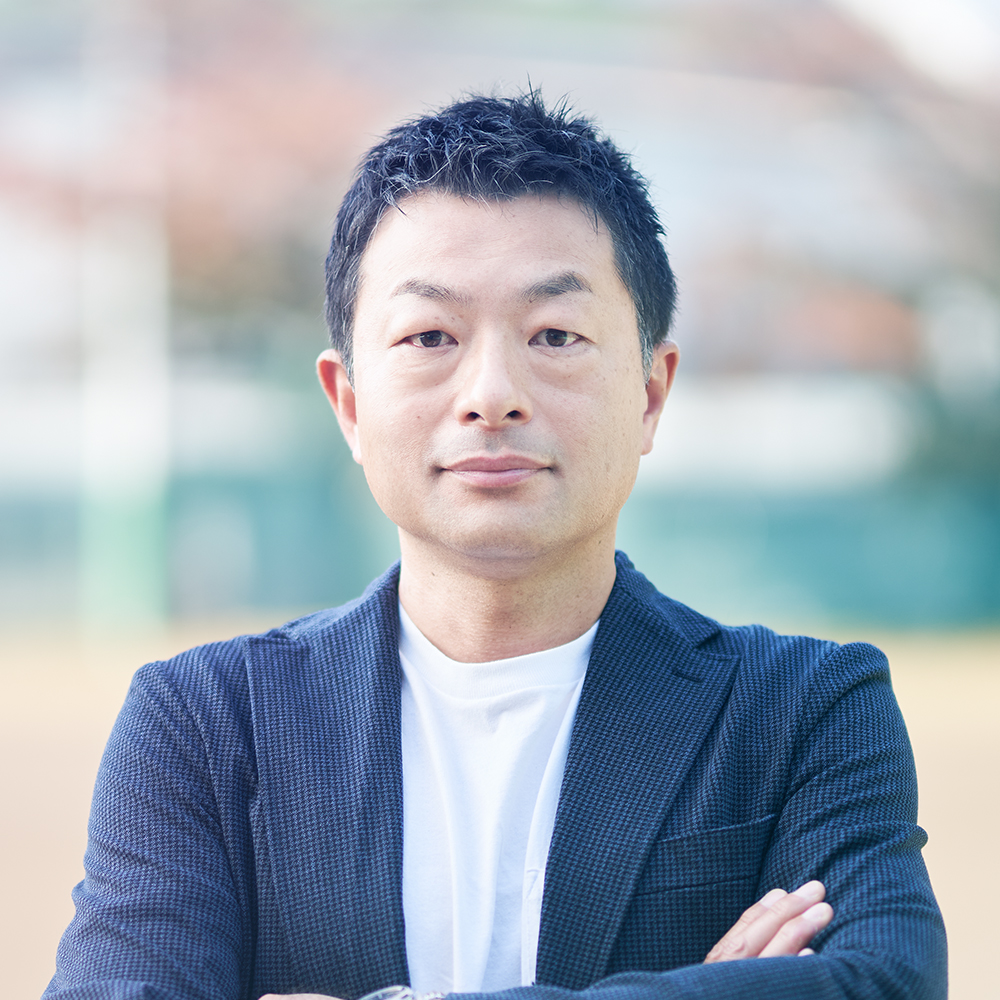- Design
- DesignThinking
- DigitalTransformation
- DX
- FujitsuDesignCenter
我々が思い描く未来とは?What is the future we envision?
- Design
- DesignThinking
- DigitalTransformation
- DX
- FujitsuDesignCenter
- DesignDrivenManagement

我々富士通デザインセンターは、複数の企業のインハウスデザイン組織が集い、解くべき大きな社会課題を我々が手に負える適度な大きさに人起点で括り出し、デザイン組織以外の仲間とも協力し合いながら解決方法の価値を検証し社会実装に繋げる、デザインを起点とするエコシステムの姿を思い描いています。
We at the Fujitsu Design Center envision a design-based ecosystem in which in-house design organizations from multiple companies gather, reduce the size of a large social problem to a size that we can handle, verify the value of a solution by collaborating with colleagues outside the design organization, and lead to social implementation.
| Designer | 宇田 哲也 |
成功する一方で感じた違和感
デザインセンターは2020年7月1日に富士通のインハウスデザイン組織として再スタートを切り、「事業への貢献だけでなく、デザインをもっと富士通の企業活動全体に活用する」をミッションとして掲げ、人のマインドセットや組織文化のデザインも含めた 社内外に対するDX(デジタルトランスフォーメーション)推進に貢献してきました。我々はそれらの活動を行いながら自らの存在価値を見直す中で、自らの存在はデザインのCoE(センターオブエクセレンス:中核拠点)であり、解くべき価値のある社会課題と課題への解決策の検証の両方を創造することが出来る、富士通にとっても、社会にとっても北極星としての役割を持つ組織であるべきとビジョンを定義しました。
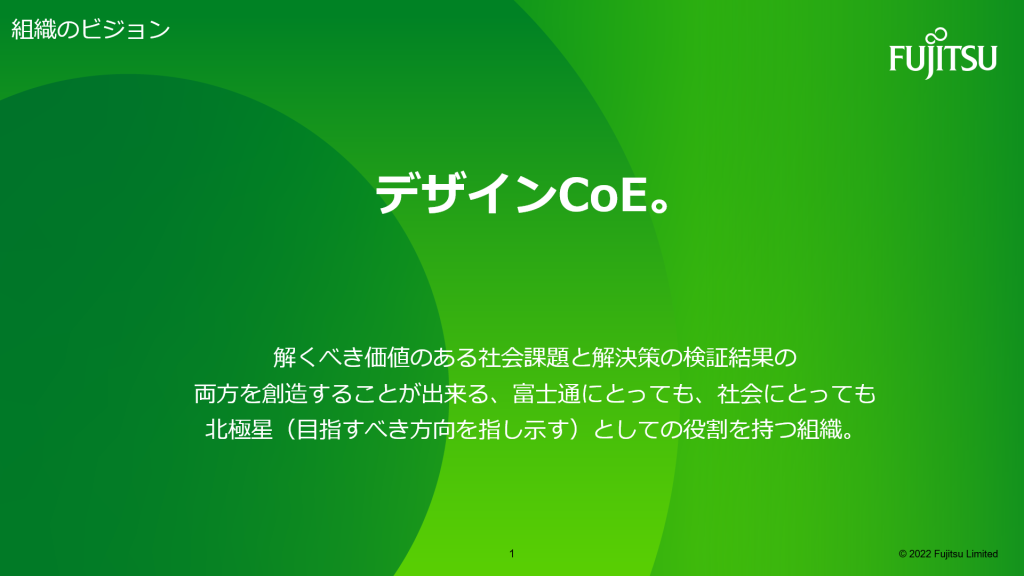
ビジョン達成に向けて日々の行動を行う中でその活動指針も示され、富士通デザインセンターの中では「挑戦者」としての気概を持ち続けることで変革に対して主体的に行動すること、さらに組織全体の成果を最大化するための横連携も求められてきました。変化の激しい時代に適合するためにデザインの対象や役割を大きく変化させながら、富士通の企業活動全体に対する貢献を継続することが出来たのは、時には過去の自分をかなぐり捨てるような変革に対しても主体性を持って挑戦してきた挑戦者精神あふれるデザイナーがあってのことだと思います。
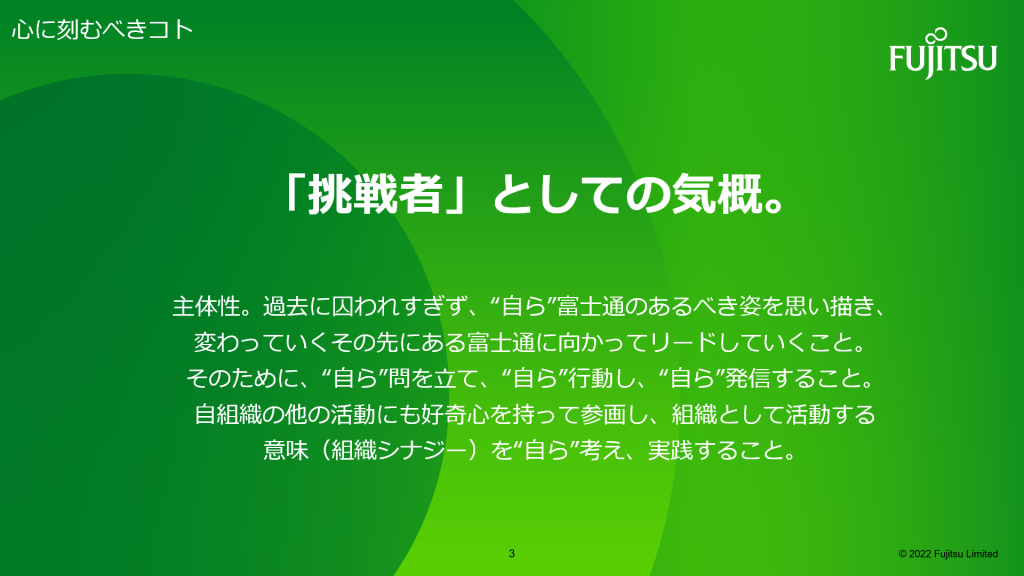
こう言ったビジョンや活動指針に基づいて活動した社内外に対するDX推進への貢献は、富士通全社に対するデザイン思考浸透プログラム、富士通社内のビジネスグループを巻き込んだ特別変革プロジェクト(通称”タスクフォース”)、富士通社内の営業部門や事業部門とのデザイン実践プログラム、人事施策としての相互人材交流、顧客との共創プロジェクトなどと広がりを見せました。開始から2年後、多くの社内変革プロジェクトでの成果が認められ、富士通社内の全社社内表彰(貢献賞)を受賞することが出来、その中でも特別な3件のうちの1件に選択されました。これは、これまで色や形を整える役割として認識されていたデザイン組織に対する社内認識が変化し、まさに重要な経営リソースの一要素である(=デザイン経営)と歓迎されたことの証明になったと思います。
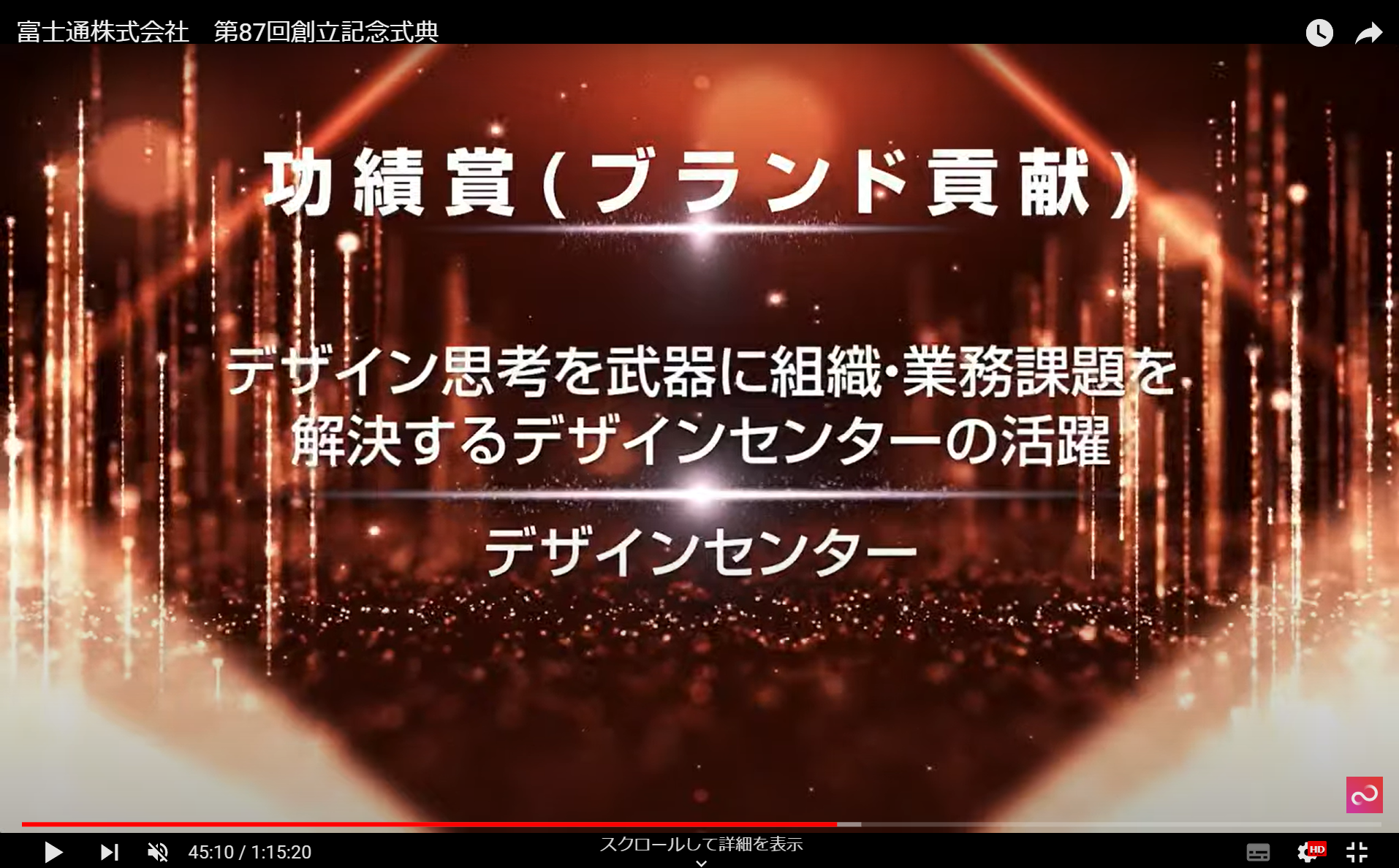
さらにこう言った企業活動全体に対する貢献は社外にも伝搬し、RIETI(独立行政法人経済産業研究所)主催のRIETI政策シンポジウム「デジタル時代の価値創出 ~デザイン経営の視点から~」(2022年6月7日開催)のパネルディスカッションにも登壇させて頂く機会を頂きました。ディスカッションの中で経営層自らがデザイン思考を体得し、その体験を本部長に伝え、さらに本部長が現場へと伝えていくことで、変革のムーブメントをトップマネージメントから起こしながら、現場と経営層の距離を近づけている点などの重要ポイントを紹介させて頂き、多くの他社の参加者の方から共感のコメントを頂きました。

富士通社内での貢献で大きな成果を挙げた一方、課題も見えてきました。それは”デザイン”の価値が”デザイン思考”を社内浸透させながら自社事業に貢献することに注力する余り、社会や生活者、日本や世界が抱える社会課題に対して直接的に向き合う時間が十分に確保できなかったという点です。もう少し大きなスケールで捉えると、富士通を含めた企業に所属するインハウスデザイン組織は自社に対する財務貢献を意識しすぎるあまり、さまざまな生活者が日常生活でもっとデザインに触れ合うような機会を作り出す取り組みや、身の回りにあふれる社会課題を自分事として捉える取り組みが十分に出来ていないのではと言う課題感でした。
企業は事業を通じて社会課題を解決しその対価を社会から獲得し、さらに新たな課題解決のために獲得した対価を次の事業に投資することで持続可能な社会を創造しているという点は疑いのない事実だと思います。一方でこう言った貢献は、
・財務貢献が厳しく問われすぎ、ニーズはあるが儲からない課題は無視される傾向にある点、
・自社の製品や技術適用が求められるため、解決される範囲が制限される点、
・事業立上に時間を要すため、必要としている人にタイムリーに解決策が届かない点、
に懸念があることが分かっていました。特にデザインは社会やそこに生活する人と共に共存する存在であり、それなしでは成立しない存在でありながら、デザインと社会課題の間に事業性としての判断を伴う点に違和感を感じながら日々のデザインを行っているデザイナーも数多くいました。
インハウスデザイン組織がやるべきこと
上記の違和感に答えを出しつつ、かつ社会課題を自分事と捉え具体的に活動を開始するための一つの方向性が、「複数のインハウスデザイン組織から構成されるエコシステムで解くべき課題を解決するもの」でした。具体的には、各企業の中に位置するインハウスデザイン組織所属のデザイナーが企業の枠組みから飛び出し、他社インハウスデザイン組織やその他の企業との“社会課題解決エコシステム”を形成し、互いの異なるバックグラウンドから形成される個々人の強みを生かしながら一丸となって社会課題解決に取り組む活動と考えました。
一方で、各インハウスデザイン組織が集い活動する中で真っ先に課題になってくるのは、活動の中で自社の秘密情報、技術情報を開示することが出来ないため議論が暗礁に乗り上げるということでした。また、インハウスデザイン組織と言っても富士通のようなB2B企業向けのDX変革に取り組む企業もあれば、B2C向けのプロダクトを基軸とした企業、B2Bのインフラを基軸とした企業もあり、各インハウスデザイン組織に所属するデザイナーの意識を統一し、方向感を出す点に苦労するのではと言う懸念もありました。
この問題に対する解決策として着目したのは、解くための手段や技術ではなく、自分達が解くべき課題の括り出しに注力することでした。課題の括り出しに注力することは、各社が持つ秘密情報、技術情報は不要であり、情報開示の問題が発生しないというポイントがあります。また、所属企業は異なるが、大きな社会課題から自分達が手における大きさに課題を括り出す点においては、すべてのデザイナーが共通的に得意とするところであり、課題起点においてはデザイナーが最も威力を発揮できる領域であると言うポイントもありました。
社会課題解決エコシステムの始動
上記の構想を実際に行動に移すために、一般社団法人電子情報技術産業協会(JEITA)のデザイン委員会の活動の範囲内において、JEITAに集まる各インハウスデザイン組織の方々と共に社会課題エコシステムを構成し活動を開始しました。JEITAデザイン委員会には各インハウスデザイン組織に所属しているデザイナーが参加されていますが、各デザイナーはそれぞれの企業において異なる経験、知見を持ち合わせており、そう言った経験、知見を組み合わせることで一企業のデザイナーだけでは括り出せなかった視点から課題の定義を行うことが出来ます。
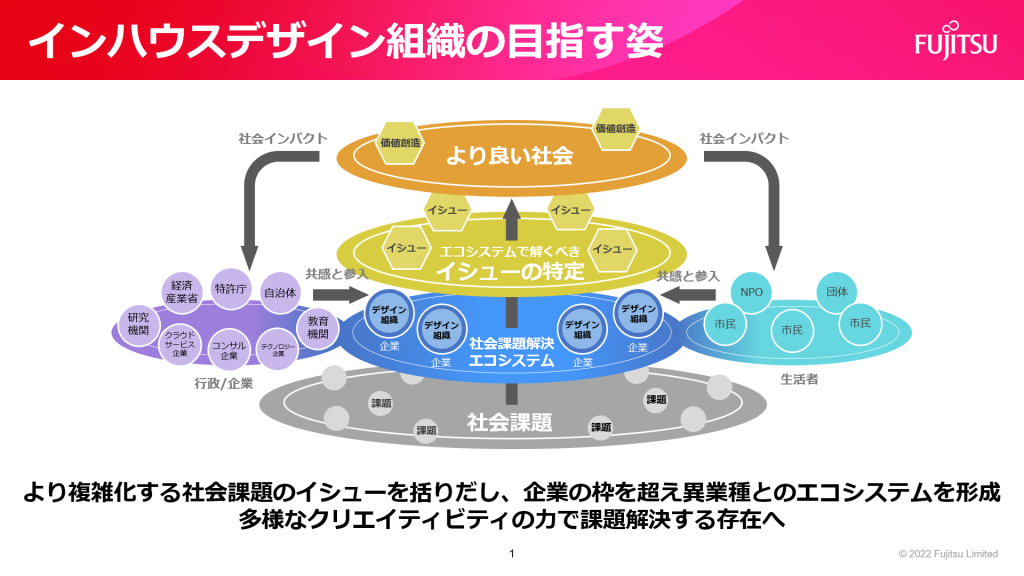
編集後記(ポストスクリプト)
社会課題解決エコシステムの活動がスタートしました。これまで特に日本企業においては同じ課題に対する解決策を、コストや納期、品質と言う競争軸において切磋琢磨してきましたが、このアプローチではスピーディーにたくさんの社会課題を解決するに至りませんでした。この根本原因は技術志向すぎるため本来解くべき課題かどうかの議論が起こりにくい日本人気質と、各企業や企業内組織がサイロ化に陥っておりどこの企業でもどこの組織でも実は同じ課題を解きあっていると言う問題だと思います。
こう言った根本課題を解決するための具体的な施策として富士通デザインセンターで取り組んでいるのは、
・富士通デザインセンターが考える課題感と解決する方向性の社会への問いかけ、
・本課題感を解決するための企業の枠を超えた仲間作りと具体的な取り組みの開始、
・活動の透明化のための、活動内容の情報発信と再利用可能な形での成果の共有方法、
・活動に参画するインハウスデザイン組織の組織価値の定量化と情報発信、
などです。本活動を通して、デザインの存在価値やデザイン組織の組織価値が再定義されると共に、社会課題が解決されることでよりよい社会作りにも貢献出来るものと考えています。
The sense of incongruity that one feels while succeeding
The Design Center relaunched on July 1, 2020 as Fujitsu’s in-house design organization, and with “not only to contribute to Fujitsu’s business, but also to make the most of its design throughout the corporate activities” as its mission, has been contributing to the promotion of DX (Digital Transformation) both inside and outside the company, including the design of people’s minds and organizational culture. As we reviewed the value of our existence while carrying out these activities, we defined our vision as the CoE (Center of Excellence) for design, an organization that can create both the definition of social issues that are worth solving and the verification of solutions to those issues, both for Fujitsu and society, as a polar star.
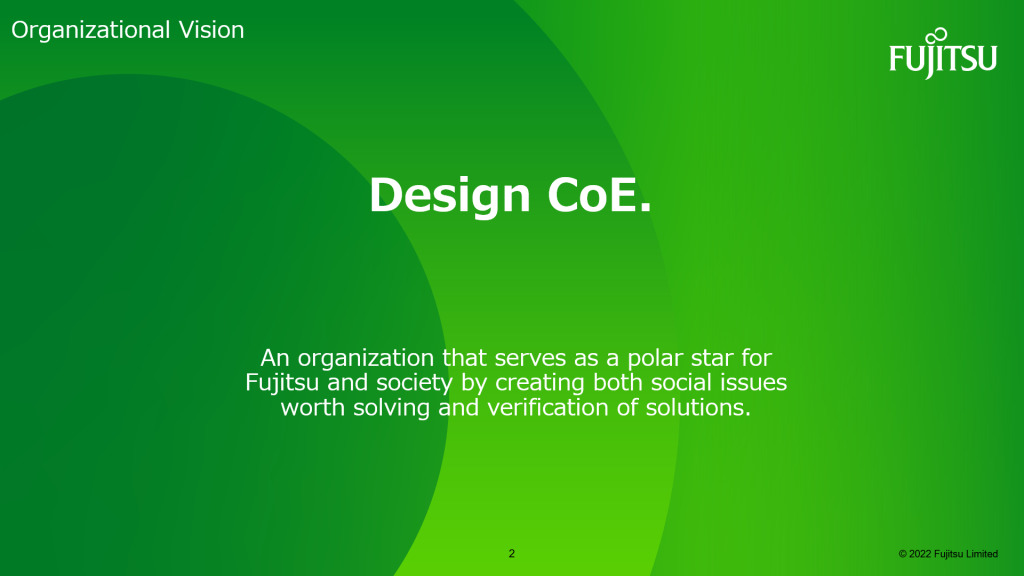
In order to achieve this vision, the Fujitsu Design Center has been required to act proactively for change by maintaining the spirit of “challenger” and to cooperate laterally to maximize the results of the entire organization. In order to adapt to the rapidly changing society, we have been able to change the objects and roles of our designs while continuing to contribute to the overall corporate activities of Fujitsu. I think it was because of the challenging spirit of our designers who took on the challenges of change, sometimes even by throwing away their past selves.

These contributions to DX promotion, both inside and outside the company, based on the vision and activity guidelines, have expanded to include a program to instill design thinking throughout Fujitsu; a special transformation project (commonly known as a “task force”) involving multiple business groups within Fujitsu; a design practice program with sales and business divisions within Fujitsu; mutual personnel exchanges as part of personnel measures; and joint creation projects with customers. Two years after its inception, Fujitsu’s Design Center was awarded a Companywide internal commendation (Contribution Award) in recognition of its many internal transformation projects, and was selected as one of three special cases. I think this is a evidence to the fact that the company’s perception of the design organization, which was previously recognized as a role to arrange colors and shapes, has changed and has been welcomed as an important element of corporate management resources.

These contributions to overall corporate activities spread outside the company, and I also had the opportunity to participate in a panel discussion on “Value Creation in the Digital Age: The perspective of design-driven management” hosted by RIETI (Research Institute of Economy, Trade and Industry) on June 7, 2022. During the discussion, the top management executives learned design thinking by themselves, and transferred the experience to the general managers. The general managers then communicated the experience to the managers and other members, and introduced important points such as the fact that the distance between members and the management was brought close, while the movement for change was created from the top management executives. Many participants from other companies gave sympathetic comments.

Design Center will play a leading role in (1) challenging social issues that require a longer global
Fujitsu’s internal contributions have yielded significant results, but at the same time challenges are emerging. The reason for this is that the value of “design” was so focused on contributing to the company’s business as to instill “design thinking” within the company that we were unable to secure sufficient time to directly face social issues facing society, consumers, Japan and the world. On a slightly larger scale, I felt that the in-house design organizations belonging to companies, including Fujitsu, were too conscious of their financial contributions to the company, and that efforts to create opportunities for various people to come in contact with design in their daily lives, and efforts to grasp the social issues surrounding them as their own affairs, were insufficient.
I think there is no doubt that companies are creating a sustainable society by solving social issues through their businesses, receiving compensation from society, and then investing the compensation they have earned to solve new issues in the next business. On the other hand, these contributions have the following concerns.
・Financial contributions are being asked too severely, and issues that are needed but not profitable tend to be ignored;
・The scope of the solution is limited by the application of the company’s products and technologies;
・Because it takes time to establish a business, solutions cannot reach those who need them in a timely manner.
In particular, design coexists with society and the people who live there, and while it cannot be established without it, there are many designers who carried out daily design while feeling a sense of incongruity in the fact that judgment as a business is involved between design and social issues.
What inhouse design organizations should do
“To solve a problem to be solved in an ecosystem composed of a plurality of in-house design organizations.” was one of the directions to start concrete activities by regarding social issues as personal matters while answering the above incongruity. Specifically, designers belonging to in-house design organizations within each company should step out of the corporate framework to form a “social problem-solving ecosystem” with other in-house design organizations and other companies, and worked together to solve social issues by leveraging the strengths of individuals formed from different backgrounds.
On the other hand, the first issue to be addressed as each in-house design organization gathers together is the fact that they cannot disclose their own confidential information and technical information in the course of their activities, and thus the discussions have become deadlocked. In addition, there are companies that are working on Digital Transformation (DX) for B2B companies such as Fujitsu, companies that are based on B2C products, and companies that are based on B2B infrastructure.
What we focused on as a solution to this problem was not the means or technology to solve it, but rather focusing on the issues that we had to solve. Focusing on reframing issues involves eliminating the need for confidential and technical information held by each company and ensuring that there are no information disclosure issues. In addition, although the companies to which we belong are different, all designers have a common strength in identifying issues of the size of their hands from major social issues, and in terms of the starting point of issues, there is also the point that designers can exert their most power.
Launch of a social problem solving ecosystem
In order to put these concepts into action, we formed a social issues ecosystem within the scope of the activities of the Design Committee of the Japan Electronics and Information Technology Industries Association (JEITA), together with the members of each in-house design organization gathered at JEITA. Designers belonging to each in-house design organization participate in the JEITA Design Committee, and each designer has different experiences and knowledge in each company. By combining these experiences and knowledge, it is possible to reframe issues from a perspective that could not be extracted by a single company designer alone.
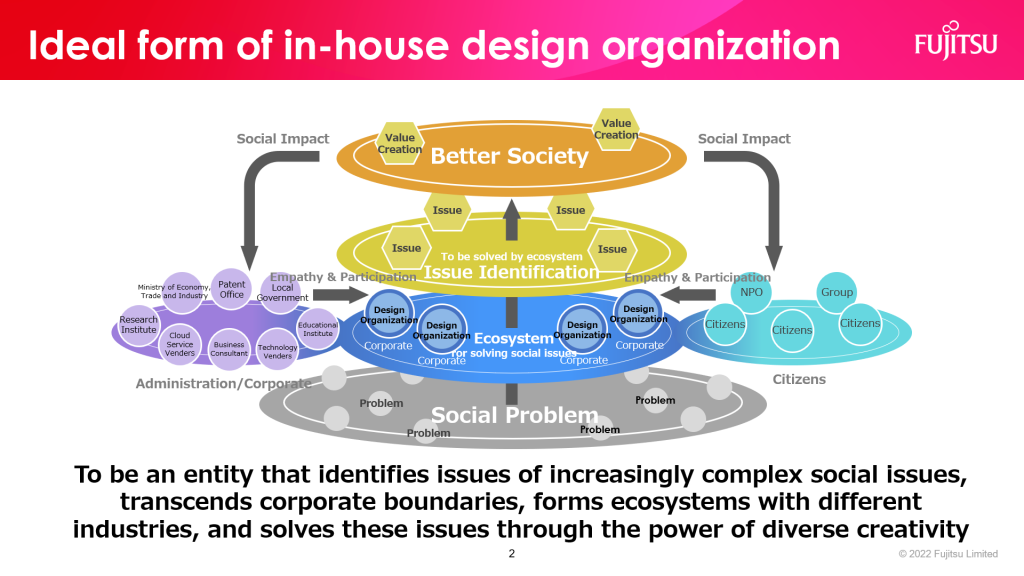
Editorial Postscript
We launched a social problem solving ecosystem. In the past, Japanese companies, in particular, have been competing for solutions to the same issues in terms of cost, delivery time and quality. However, this approach has not been able to resolve many social issues quickly. The root cause of this problem is the Japanese mentality that makes it difficult to discuss whether it is a problem that should be solved or not because they are too technology-oriented, and the problem that every company and every organization in the company has fallen into a silo, and every company and every organization actually solves the same problems.
The Fujitsu Design Center is working on specific measures to solve these fundamental issues.
・The Fujitsu Design Center’s thoughts on issues and directions for solving social issues,
・In order to solve this problem, we have started to make partners beyond the framework of the company and to take concrete measures.
・How to communicate information on activities and share results in a reusable manner for transparency of activities;
・Quantifying the organizational value of in-house design organizations participating in the activities and communicate information,
and so on. Through these activities, we believe that we can redefine the existence value of design and the organizational value of the design organization, and contribute to the creation of a better society by solving social issues.
FACEのメンバーに興味を持っていただけたでしょうか?
お仕事のご依頼や転職を検討するにあたり聞いてみたいことなど、
現場のデザイナーがお応えしますのでお気軽にご連絡ください。


